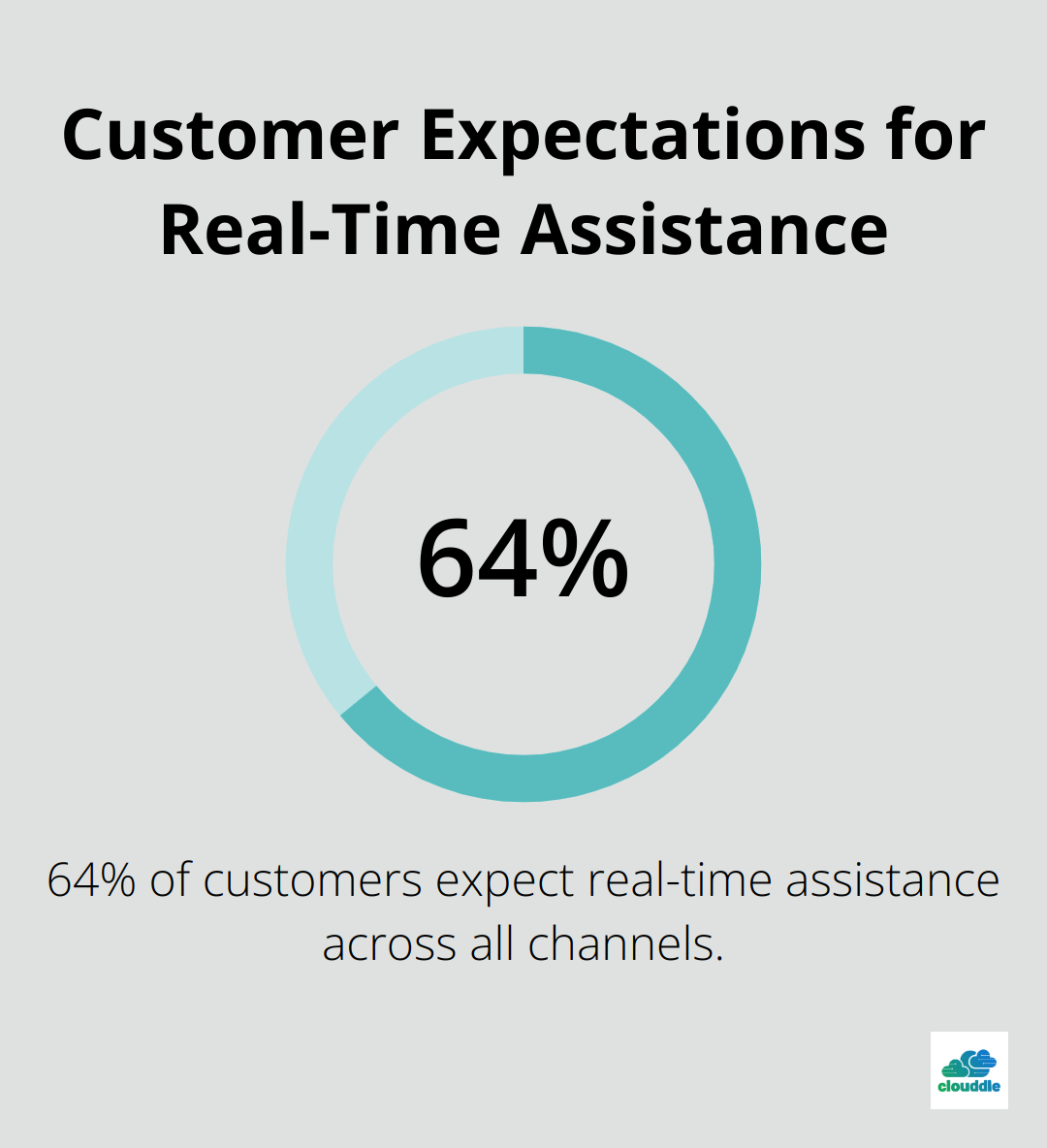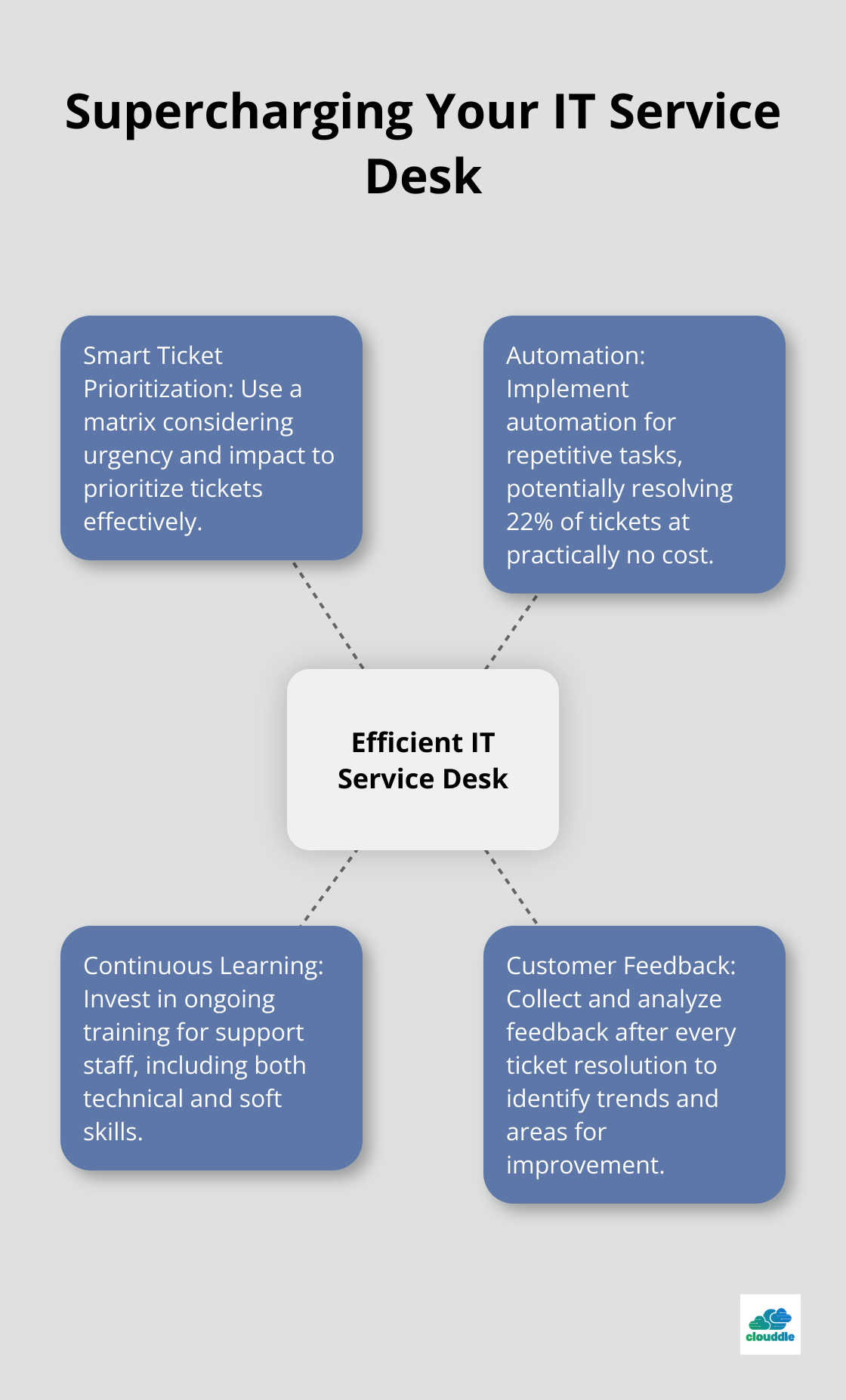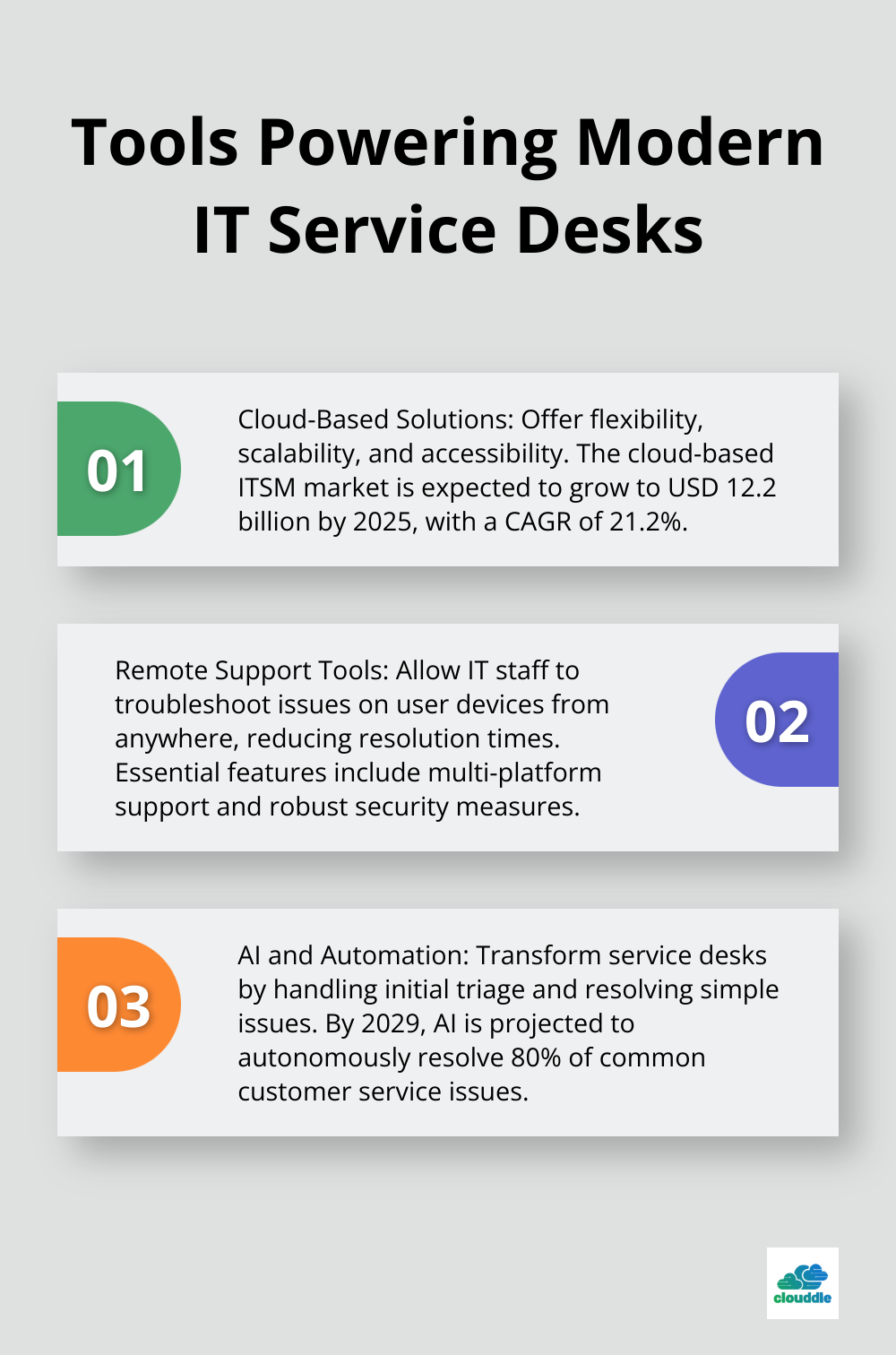Setting up an efficient managed IT service desk is a game-changer for businesses of all sizes. At Clouddle, we’ve seen firsthand how a well-organized service desk can streamline operations and boost productivity.
This guide will walk you through the essential components, best practices, and cutting-edge tools needed to create a top-notch IT support system. Get ready to transform your IT service desk into a powerhouse of efficiency and customer satisfaction.
What Makes an IT Service Desk Efficient?
An efficient IT service desk forms the backbone of smooth business operations. It solves problems quickly and keeps users happy. But how do you build one that really works?
The Power of a Good Ticketing System
A solid ticketing system acts as your command center. It’s not just about logging issues. Look for a system that can categorize tickets, assign them automatically, and track their progress. A study by HDI shows that organizations using advanced ticketing systems see a 32% increase in first-contact resolution rates.
Many clients reduce their average resolution time by 40% just by implementing a smart ticketing system. It’s not about the fanciest features; it’s about finding a system that fits your workflow and makes life easier for your team.
Communication is Key
Clear communication channels are non-negotiable. This means having a single point of contact for users and a streamlined process for your team. Don’t make users guess how to reach you. Offer multiple channels (phone, email, chat) but funnel them into one system.
A Zendesk survey found that 64% of customers expect real-time assistance regardless of the channel they use. Make sure your channels integrate and your team can respond quickly, no matter how a user reaches out.

SLAs: Setting Expectations Right
Service Level Agreements (SLAs) aren’t just paperwork; they’re your promise to users. Be realistic when setting these. If you promise 15-minute response times but can’t deliver, you set yourself up for failure.
Break down your SLAs by issue type and priority. A critical server outage needs a faster response than a password reset. Tracking SLAs ensures service quality, enhances accountability, boosts customer satisfaction, and helps businesses optimize efficiency.
Knowledge is Power: Build Your Base
A comprehensive knowledge base is your secret weapon. It’s not just for your team; it’s for your users too. Self-service options can reduce ticket volume dramatically. Using self-service password resets, for example, can lead to significant cost savings. The average uReset customer saved $64,610 in 2023 or $136 per end user on password resets alone.
Start small. Document the top 20 most common issues and their solutions. Update this regularly based on new tickets. Make it searchable and easy to navigate. Try to make it so good that users prefer checking it before submitting a ticket.
An efficient IT service desk doesn’t appear overnight. It requires continuous improvement. Keep tracking your metrics, listening to user feedback, and adjusting your approach. With these components in place, you’re well on your way to creating a service desk that not only resolves issues but also adds real value to your organization. Now, let’s explore the best practices that will take your IT service desk to new heights of efficiency and user satisfaction.
How to Supercharge Your IT Service Desk

Smart Ticket Prioritization
Not all tickets deserve equal attention. A smart prioritization system can transform your service desk from good to great. We recommend using a matrix that considers both urgency and impact. For example, a server outage affecting 100 users should take precedence over a single user’s printer issue.
Performance statistics can help you identify which support agents are top performers and illuminate opportunities for additional training. To achieve this, create clear guidelines for your team. Define what constitutes a high-priority ticket and ensure everyone understands these criteria.
Automation: Your New Efficiency Booster
Repetitive tasks can slow down your service desk. Automation offers a solution to this problem. Start with common issues: password resets, software installations, and basic system checks.
22% of total service desk tickets can be resolved at practically no cost with the help of automation. This statistic emphasizes the potential for efficiency gains through automated processes.
Try implementing chatbots for initial triage. These can handle simple queries and guide users to self-service resources, allowing your team to focus on more complex issues.
Continuous Learning for Your Team
Your service desk’s quality depends on the people running it. Invest in ongoing training for your support staff. This includes both technical skills and soft skills like communication and problem-solving.
Address this issue by creating a structured learning program. Include both technical certifications and customer service training.
The Power of Customer Feedback
Customer feedback provides invaluable insights. Implement a system to collect feedback after every ticket resolution. But don’t stop there – analyze this data regularly.
Use tools that can help you spot trends in your feedback. Are certain issues recurring? Does your team excel or struggle in particular areas?
Act on this feedback. If users consistently report confusion with a particular system, consider creating a user guide or updating the UI. If your team receives praise for quick resolutions, identify the successful processes and replicate them across other areas.
An efficient IT service desk requires constant refinement and adaptation. These practices aren’t one-time solutions. They demand ongoing attention and adjustment based on data and user feedback. As we move forward, let’s explore the cutting-edge tools and technologies that can take your IT service desk to the next level of efficiency and user satisfaction.
Tools That Power Modern IT Service Desks

Cloud-Based Solutions: The New Standard
Cloud-based service desk solutions have become indispensable. They offer flexibility, scalability, and accessibility that on-premise systems can’t match. The cloud-based ITSM market is expected to grow from USD 4.7 billion in 2020 to USD 12.2 billion by 2025, at a Compound Annual Growth Rate (CAGR) of 21.2% during the forecast period.
A key feature of cloud solutions is their ability to integrate with other business tools. This integration can lead to significant time savings. For example, connecting your service desk with your asset management system can automatically populate ticket information, reducing manual data entry.
Remote Support: Breaking Geographic Barriers
Remote support tools have become essential, especially with the rise of remote work. These tools allow IT staff to troubleshoot issues on user devices from anywhere, dramatically reducing resolution times.
When selecting a remote support tool, look for features like multi-platform support, session recording, and robust security measures.
AI and Automation: The Efficiency Multipliers
AI-powered chatbots and automation tools are transforming service desks. They handle initial triage, answer common questions, and even resolve simple issues without human intervention.
By 2029, agentic AI will autonomously resolve 80% of common customer service issues without human intervention, leading to a 30% reduction in operational costs. When implementing AI tools, start small. Focus on automating your most common and straightforward requests first, then gradually expand as you see results.
Analytics: Data-Driven Decision Making
Analytics and reporting software are the unsung heroes of modern service desks. They provide insights that can drive continuous improvement. Try to find tools that offer real-time dashboards, customizable reports, and predictive analytics.
When leveraging analytics, focus on actionable metrics. Don’t just track numbers; use them to identify bottlenecks, predict future issues, and make data-driven decisions to improve your service.
These tools can transform IT support operations. While many options are available, it’s important to choose tools that integrate well with your existing systems and align with your specific needs. The goal isn’t to have the most tools, but to have the right tools that enhance your team’s capabilities and improve user satisfaction. Implementing managed WiFi services can further boost your network reliability and give your business a competitive edge in today’s connected world.
Final Thoughts
An efficient Managed IT Service Desk combines key components with best practices to create a powerhouse of support efficiency. Modern tools and technologies, such as cloud-based solutions and AI-powered chatbots, have become essential for meeting user expectations in our digital world. A well-managed IT service desk enhances business productivity, reduces downtime, and improves user satisfaction.
Clouddle offers comprehensive managed IT services designed to help businesses streamline their IT support and enhance network reliability. Our solutions enable companies to focus on core business objectives while staying current with technology trends and best practices in IT service management. We strive to provide seamless experiences for both employees and customers.
An efficient IT service desk provides a competitive advantage in today’s fast-paced business environment. It empowers businesses to respond quickly to challenges and adapt to new technologies (a critical factor for success). Continuous evaluation and improvement maintain a high-performing IT support system that evolves with your business needs.


